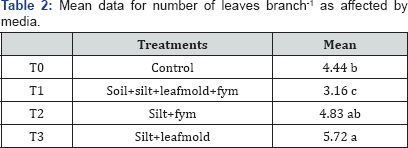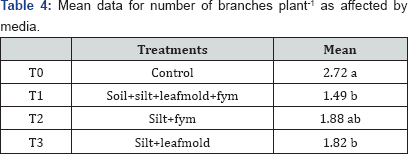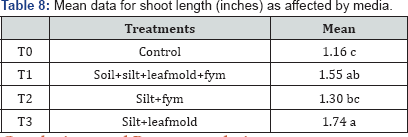Different Media Effect on Various Characteristics of Floribunda Rose (Rosa spp)
Majid Hissam*1, Inayat Ur Rahman1, Shamsher Ali3, Irshad Ali Khan2, Muhammad Adnan1, Muhammad Ilyas4, Abdullah, Shahab Ali5, Zia Ullah3, Nawab Ali6 and Muhammad Mehran Anjum6
1Department of Horticulture, the University of Sawabi, Pakistan
2 Department of Entomology, the University of Sawabi, Pakistan
3Department of soil and environmental sciences, University of agriculture, Pakistan
5Department of Horticulture, University of Abdul Wali Khan Mardan, Pakistan
6Department of Agronomy, University of agriculture Peshawar, Pakistan
Submission: September 10, 2017; Published: September 21, 2017
*Corresponding author: Majid Hissam, Department of Horticulture, the University of Sawabi, Pakistan, Tel: 3028882178, Email: majidssam3@gmail.com
How to cite this article: Majid H, Inayat U R, Shamsher A, Irshad A K, Muhammad A, Muhammad I, Abdullah, Shahab A, Zia U, Nawab A, Muhammad M A. Different Media Effect on Various Characteristics ofFloribunda Rose (Rosa spp). Int J Environ Sci Nat Res. 2017;5(2): 555659. DOI: 10.19080/IJESNR.2017.05.555659
Abstract
An experiment at Floriculture section of Agricultural Research Institute Tarnab Peshawar was carried out in 2016 to study the effect of soil, silt, leaf mold and FYM on various characteristics of Floribunda rose (Rosa Day Breaker) such as days to 50% sprouting, number of leaves plant-1, number of branches, number of leaves per branch, number of buds, callus diameter (inches), shoot diameter (cm), and shoot length (inches).The experiment was laid out in Randomized Complete Block Design (RCBD) with four treatments and three replications. Number of leaves branch-1, number of branches plant-1, callus diameter (inches), shoot diameter (cm) and shoot length were significantly affected by media, while no significant effect of media was recorded on days to 50 % sprouting, number of buds and number of leaves.
Keywords: Floribunda; Media; (RCBD); Replications; Treatments
Introduction
Rose, a symbol of affection, elegance, inspiration, sensuality, spirituality and source of aesthetic gratification for human beings, is one of the leading cut flowers in global floriculture trade. It belongs to genus Rosa of family Rosaceae, which contains 200 species and more than 18,000 cultivars [1]. It has always been the most favorite flower in the subcontinent. There is hardly any event where roses are not displayed in varied fashion. Cut rose flowers play an important role in interior decoration and add charm to different social and cultural ceremonies. Pakistan, being an agricultural economy, with diverse agro climatic a condition has a great potential for cut rose production. According to a survey, roses are being grown as cut flowers on 1,300 acres of land in Punjab [2] and an increase is being witnessed in rose cultivation in Pakistan. However, the technology being used is primitive which is a major hurdle in flourishing this industry in the country. Therefore, there is dire need to standardize production and handling technology for getting higher yields of better quality to compete in international markets. For this purpose, optimization of growing substrate is important as the substrates play a vital role in quality flower production. Various soilless substrates have successfully been used for several decades to intensify production and reduce cost [3].
These substrates have marked influence on plant’s health and vigor by dint of their role as a basic medium. A light, rich, porous and well drained medium is considered ideal for roses. Higher yield of best quality stems is entirely based on physico-chemical characteristics of growing substrates. Moreover, the fact that roses, unlike most other crops, are being constantly harvested and thereby exhibiting large fluctuation of the transpiring area must be taken into consideration when attempting to select a growing medium [4].
Studied that soilless cultivation of roses grown in perlite/ coconut coir dust increased yield and stem quality which might be related to the higher water holding capacity and cation exchange capacity of coconut coir, suggesting this organic material as one of the alternatives to peat for hydroponic culture. Cultivation of roses in soilless substrates is being practiced by using sand culture and nutrient flow technique (Takano, 1988); gravel culture [5]; organic substrates, mineral wool and aeroponics [6,7] and perlite [8]. There is a continuing interest in using various agricultural by products as an organic nutrient source for plants on account of their easy availability at cheaper prices and higher, slow release nutritional constituents [9,10].
Keeping in view the socio economic value of cut roses and emerging needs to standardize the technology for commercial rose production, this study was conducted with the objective to standardize growing substrate for cut rose production by incorporating easily available agricultural byproducts. A better understanding regarding the effectiveness of various growing substrates in improving growth, yield, manipulating soil characteristics and nutrient uptake would help to recommend a medium to the industry for quality rose production.
Materials and Methods
To study the effect of different growing media on floribunda rose (Rosa Day Breaker). An experiment was conducted at Floriculture section of Agricultural Research Institute Tarnab Peshawar in 2016. The experiment was laid out in Randomized Complete Block Design (RCBD) with four treatments and three replications.
a) Cuttings: 7-8 inches cuttings were taken from floribunda rose through sharp scissors.
b) Media preparation: The potted media was thoroughly prepared before the planting of rose cutting with the help of spade. Four different types of media soil, silt, leaf mold, FYM and the fifth one control were used.
c) Plastic bags: After media preparation plastic bags of 6 inches was filled from the media. In the bags rose cuttings was planted at a depth of 2-3 inches.
d) Irrigation and weeding: First irrigation was given just after plantation and then the cuttings were irrigated after specific interval of time through fountain. Weeds were removed manually.
e) Parameters studied: The following parameters were studied in the experiment.
a) Days to 50 % sprouting: Days to 50 % sprouting was counted from date of sowing.
b) Number of leaves plant-1: Number of leaves plant-1 was recorded by randomly selecting few plants from each treatment and then the average was calculated.
c) Number of branches plant-1: Number of Branches plant-1 was recorded by randomly selecting few plants from each treatment and then the average was calculated.
d) Number of leaves branch-1: Number of leaves Branch-1 was recorded by randomly selecting few plants from each treatment and then the average was calculated.
e) Number of Bud's plant-1: Number of Bud's plant-1 was recorded by randomly selecting few plants from each treatment and then the average was calculated.
f) Callus Diameter (inches): For callus diameter determination six plants was randomly selected in each treatment, diameter was determined through vernier caliper and then average diameter was calculated.
g) Shoot Diameter (cm): For shoot diameter determination six plants was randomly selected in each treatment, diameter was determined through vernier caliper and then average diameter was calculated.
h) Shoot length (inches): Shoot length was calculated through measuring tape by randomly selecting few plants from each treatment and then the average was calculated.
Statistical Procedure
The data were collected on different parameters and subjected to analysis of variance (ANOVA) using statistical package statistix 8.1. Least significant difference (LSD) test was used for finding significant differences between the means in case of significant results (Table 1).

Results and Discussion
a) Days to 50% sprouting: ANOVA regarding days to 50 % sprouting shows that media had no significant effect on days to 50 % sprouting [11]. Also found that media had no significant effect on days to 50 % sprouting.

b) Number of leaves branch-1: ANOVA regarding number of leaves branch-1 shows that number of leaves plant-1 was significantly affected by media. Mean data in (Table 2) shows that significantly highest number of leaves branch-1 were recorded for T3 and T2 followed by control while least number of leaves plant-1 were noted for T1[12,13]. Also found that media had significant effect on number of leaves branch-1. ANOVA regarding number of leaves plant-1 shows that media had no significant effect on number of leaves plant-1 [14]. Also found that media had no significant effect on number of leaves plant-1.
c) Number of branches plant-1: ANOVA regarding number of branches plant-1 shows that of branches plant-1 was significantly affected by media. Mean data in (Tables 3 & 4) shows that significantly highest number branches plant-1 were recorded for control and T2 followed by T3 while least number of branches plant-1 was noted for T1 [15]. Also found that media had significant effect on number of branches plant-1.


d) Callus Diameter (inches): ANOVA regarding callus diameter (inches) shows that callus diameter (inches) was significantly affected by media.Mean data in (Tables 5 & 6) shows that significantly highest callus diameter (inches) were recorded for T3 and control followed by T1 while least callus diameter (inches) were noted for T2 [16]. Also found that media had significant effect on callus diameter (inches).


e) No of buds: ANOVA regarding No of buds per plant shows that media had no significant effect on No of buds per plant [17]. Also found that media had no significant effect on No of buds.
f) Shoot diameter (cm): ANOVA regarding shoot diameter (cm) shows that shoot diameter (cm) was significantly affected by media. Mean data in Table 7 shows that significantly highest shoot diameter (cm) were recorded for T3 and T1 followed by T2 while least shoot diameter (cm) were noted for control [18]. Also found that media had significant effect on shoot diameter (cm).

g) Shoot length (inches): ANOVA regarding shoot length (inches) shows that shoot length (inches) was significantly affected by media. Mean data in (Table 8) shows that significantly highest shoot length (inches) were recorded for T3 and T1 followed by T2 while least shoot length (inches) were noted for control [18]. Also found that media had significant effect on shoot length (inches) [19-31].

Conclusion and Recommendation Conclusion
a) From the experiment it is concluded that media had significant effect on callus diameter (inches), shoot length (inches), shoot diameter (cm), number of branches and number of leaves per branch while non significant effect of media was noted for days to 50% sprouting, number of leaves per plant and number of buds.
b) The combination of silt and leaf mold gave us best result as compared to other treatments, so this combination is recommended for floribunda rose.
References
- Gudin S (2000) Rose genetics and breeding. J Janick Reviews John 17(3).
- Khan MA (2005) Development of commercial floriculture in Asia and Pacific: Issues, challenges and opportunities Proceedings of national saminar on streamlining production and export of cut flowers and house plants. A Saeed Hort Foundation Pak, pp 36.
- Maloupa E, I Mitsios, PF Martinez, S Bladenopoulou (1992) Study of substrate use in Gerbera soilless culture grown in plastic greenhouses. Acta Hort 323: 139-144.
- Fascella, Zizzo (2000) studied the Effect of Growing Media on Yield and Quality of Soilless. Istituto Sperimentale perla Floricoltura, Sezione di Palermo p. 1-6.
- Sarro MJ, MJ Samchez, C Miyar, P Zornoza (1989) Nutritional requirements of two rose cultivars grown in gravel culture. Acta Hort 246: 219-222.
- Zieslin N, P Snir (1989) Response of rose plants cultivar 'Sonia' and Rosa indica Major to changes in pH and aeration of the root environment in hydroponic culture. Scientia Hort 37: 339-349.
- Kool MTN, PA van de Pol (1991) The rose cultivar Madelon on rockwool. The rootstock has a considerable influence on flower yield. Vakblad voor de Bloemisterij 46: 62-64.
- Katsoulas N, C Kittas, A Baille (1999) Transpiration and canopy resistance of greenhouse soilless roses: measurements and modeling. Acta Hort 507: 61-68.
- Mikkelsen RL (2003) Using tobacco by-products as a nitrogensource for container-grown houseplants. J Pl Nutri 26:1697-1708.
- Ahmad I (2009) Production potential and postharvest management of cut rose flowers in Punjab (Pakistan). Doctoral Thesis, Univ of Agric, Faisalabad, Pakistan.
- M Abad, P Noguera, S Bures (2001) National inventory of organic wastes for use as growing. Bioresour Technol 77(2): 197-200.
- A Riaz, M Arshad, A Younis, A Raza, M Hameed (2008) Effect of different growing media
- Abad M, P Noguera, R Puchades, A Maquieira, V Noguera (2002) Physio- chemical properties of somecoconut dusts for use as a peat substitute for containerize ornamental plants. Bioresour Technol 82(3): 241-245.
- Grassotti A, Nesi B, Maletta M, Magnani G (2003) Effects of growing media and planting time on lily hybrids in soilless culture. FAOGUS .
- Fascella G, Zizzo GV, Costantino C, Agnello S (2003) Effect of different substrate on soil less cultivated rose. Acta Hort 697: 133-138.
- Eleni M, Sabri K, Dimitra Z (2001) Effect of growing media on the production and quality of two rose varieties. Acta Hortic ulturae 548: 79-83.
- Fascella G, GV Zizzo (2005) Effect of growing media on yield and quality of soil less cultivated rose. Acta Hort. 697: 133-138.
- Tahir Mehmood, Waqas Ahmad (2013) Comparative Effect of Different Potting Media on Vegetative and Reproductive Growth of Floral Shower (Antirrhinum majus L). Universal Journal of Plant Science 1(3): 104111.
- Buck JS, MR Evans (2010) Physical properties of ground parboiled fresh rice hulls used as a horticultural substrate. Hort Science 45: 643649.
- Evans MR, MM Gachukia (2007) Physical properties of sphagnum peat based root substrates amended with perliteor parboiled fresh rice hulls. Hort Technology 17: 312-315.
- Fagge, manga (2011) Effect of sowing media and gibberellic acid on the growth and Seedling establishment of bougainvillea glabra, ixora coccinea and rosa chinensis. Bayero Journal of Pure and Applied Sciences 4(2): 155-159.
- Fatima Kakoei and Hassan Salehi (2013) Effects of Different Pot Mixtures on spathiphyllum (Spathiphyllum wallisii Regel) Growth and Development. Journal of Central European Agriculture 14(2): 140-148
- Ginova and Tsvetkov (2012) Rosa damascena Mill. An overview for evaluation of propagation Methods. Bulgarian Journal of Agricultural Science 18 (4): 545-556.
- Holcomb JA, Michael S, Lenhart, J Rowe (2008) The potential for rice hulls. Greenhouse Product New 8: 29-32.
- H Wisniewska Grzeszkiewicz, M Podwyszynska (2001) Propagation of ground cover roses by stem cutting and tissue culture. Acta Hortic 547: 45.
- Iftikhar ahmad, M Aslam khan (2012) Effect on growth, yield and quality of rosa hybrid. Pak J Bot 44(1): 177-185.
- Kamath SR, A Proctor (1998) Silica gel from rice hull ash: Preparation and characterization. Cereal Chem 75: 484-487.
- Marta Joanna monder (2011) Evaluation of growth and flowering of Cultivars derived from the pimpinellifolia (rosa pimpinellifolia l). Journal of Fruit and Ornamental Plant Research 19(1): 195-207.
- (2001) Media for ornamental potted plant production: case study in Spain, Bioresource Technology 77: 197-200.
- Sambo P, F Sannazzaro, MR Evans (2008) Physical properties of ground fresh rice hulls and sphagnumpeat used for greenhouse root substrates. Hort Technology 18: 384-388.
- Takano T (1988) Effect of conductivity and temperature of nutrient solution on the mineral nutrition of horticultural crops in water culture. Acta Hort 230: 299-302.






























